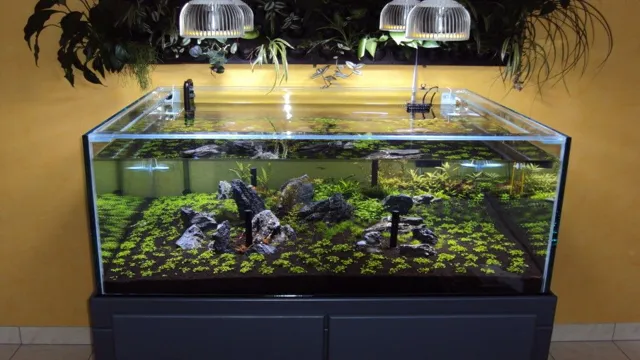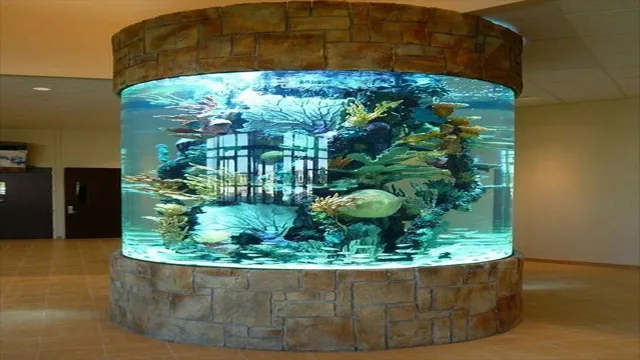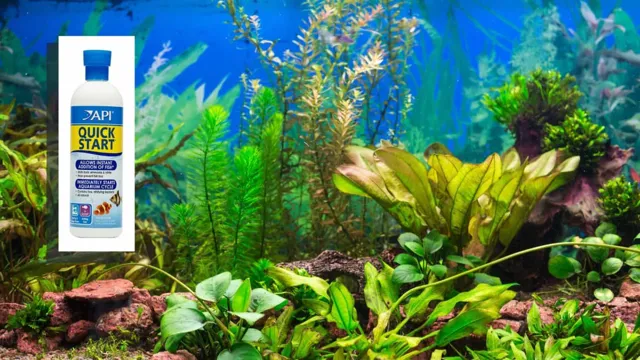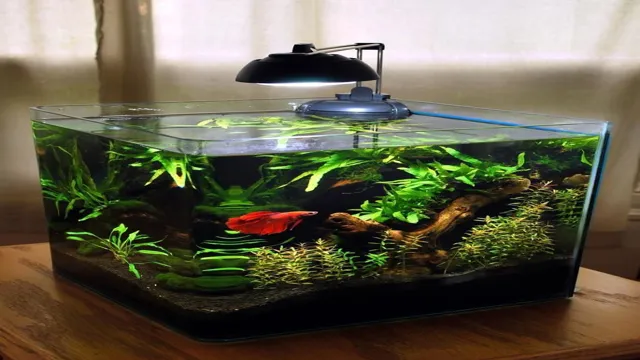If you’re an aquarium enthusiast, you know that lighting is a crucial factor in the success of your planted aquarium. The right lighting can make all the difference between a thriving, lush aquarium and a struggling, lackluster one. However, with so many options on the market, selecting the optimal lighting for your planted aquarium can seem overwhelming.
It’s essential to understand that every plant species has different lighting requirements. Therefore, there’s no one-size-fits-all solution when it comes to lighting for your planted aquarium. Factors such as the size of your aquarium, the type of plants you have, and the intensity of light needed can make choosing the right lighting even more complex.
In this blog, we’ll explore everything you need to know about choosing the right light for your planted aquarium, from the essential terminology to the different types of lighting options available. By the end of this article, you’ll have a better understanding of what your planted aquarium needs and what to look for when purchasing lighting. So, let’s dive in and illuminate the path to a beautiful, thriving planted aquarium!
Understanding Light Requirements for Aquarium Plants
Choosing the right light for your planted aquarium can be a bit overwhelming, but once you understand the light requirements of your plants, it becomes much easier. When selecting a light source, consider factors such as intensity, duration, and color. Intensity refers to how strong the light is and should be measured in lumens or PAR (Photosynthetically Active Radiation).
Duration refers to the amount of time the light will be on each day. Generally, aquarium plants require 10 to 12 hours of light per day, mimicking natural daylight. Color temperature is also important, as different spectrums of light will affect the way your plants grow.
Choosing a light with a spectrum around 6500K will encourage healthy growth and natural coloration. Remember to also consider the size of your aquarium and the type of plants you have, as this will also affect your lighting needs. With these considerations in mind, you can find the perfect light source for your planted aquarium and create a healthy, thriving aquatic ecosystem.
Intensity
When it comes to growing aquatic plants in your aquarium, understanding the light requirements is crucial for their overall health and growth. Intensity plays a major role in determining the success of your planted tank. The intensity of light refers to the amount of light that is received by the plants.
It is measured in PAR (Photosynthetically Active Radiation) or lux. Different types of plants have different light requirements, and it is important to ensure that you provide them with the right intensity of light. If the light is too intense, it can cause the leaves of the plants to burn, while too low intensity can slow down their growth and cause them to become weak.
As a general guideline, high-tech planted tanks require a higher intensity of light, while low-tech tanks need less. By understanding the light requirements of your plants and providing the right intensity of light, you can create a thriving and beautiful planted aquarium.

Color Temperature
Color Temperature When it comes to setting up an aquarium for your plants, lighting is one of the most crucial factors to consider. Plants require light to photosynthesize and grow, and the right lighting conditions can be the difference between success and failure. Understanding color temperature is essential to choose the right lighting for your aquarium plants.
Color temperature is measured in degrees Kelvin, and it determines the color of the light emitted by a bulb. Plants require different color temperatures at different stages of growth, and it is important to choose a bulb that corresponds to their needs. For example, a bulb with a color temperature of 5000K-7000K is ideal for plants in the vegetative stage, while a bulb with a color temperature of 6500K-10000K is best for plants in the flowering or fruiting stage.
By selecting the right color temperature for your aquarium plants, you can ensure that they receive the optimal amount of light for their growth and development.
Duration
Duration When it comes to aquarium plants, understanding their light requirements is essential for their growth and overall health. Light is one of the most significant factors in the photosynthesis process, which is how plants produce energy and grow. The duration of light exposure also plays an essential role; too much or too little can cause negative effects.
Generally speaking, most aquarium plants require a minimum of 8 hours of light per day to thrive. However, each species has its own unique light requirements, and it’s crucial to research and understand them before placing them in your aquarium. Some plants may require more light and longer duration, while others may prefer less. (See Also: How to Design a Planted Aquarium: Step-by-Step Guide for Beginners)
Providing the adequate amount of light and duration is crucial for the growth and success of your aquarium plants. Otherwise, they may become stunted, discolored, or even die.
Types of Lights for Planted Aquariums
When it comes to choosing the right kind of lighting for your planted aquarium, there are several options available on the market. First, you need to consider the type of plant you have in your aquarium since different plants require different levels of light intensity. Secondly, it’s essential to think about the spectrum of the light since different plants require different wavelengths of light to grow effectively.
Another factor to consider is the size of your aquarium and the light coverage needed to provide light to all areas evenly. Finally, you need to think about the cost and energy efficiency of the lighting system you’re considering. So, before selecting a lighting system, research the plants you have, check the spectrum, coverage area, and energy efficiency of the choice.
By taking all these aspects into account, you can choose the ideal light for your planted aquarium that will give your plants the proper environment they need to grow and thrive.
Fluorescent Lights
When it comes to lighting for a planted aquarium, there are a few different options. One popular choice is fluorescent lights. These lights are relatively inexpensive and provide a wide range of colors, making them ideal for promoting plant growth.
There are two main types of fluorescent lights: T5 and T T5 lights are more powerful and efficient, but they also generate more heat. T8 lights, on the other hand, are less powerful but produce less heat.
Both types of lights come in a variety of spectrums, including full-spectrum, daylight, and plant-specific spectrums. When choosing the right fluorescent lights for your aquarium, consider the needs of your plants and the size of your tank. It’s also a good idea to invest in a timer so that you can create a consistent lighting schedule that mimics the natural day/night cycle.
With the right lighting, your planted aquarium can flourish and become a beautiful oasis for your aquatic pets.
LED Lights
LED lights have become increasingly popular among aquarium enthusiasts due to their energy efficiency and customizable features. When it comes to planted aquariums, there are several types of LED lights to choose from. Full spectrum lights are designed to mimic natural sunlight and provide a wide range of wavelengths that are beneficial for plant growth.
High-output LED lights are great for aquariums with higher lighting needs, such as those with high-demand plants or deep tanks. For aquariums with low-light plants, lower output LED lights may be sufficient and more economical. It’s important to consider both the wattage and PAR (photosynthetically active radiation) of the LED lights before deciding on the best option for your planted aquarium.
With the right LED lights, maintaining a thriving planted aquarium can be a rewarding and enjoyable experience.
Metal Halide Lights
Metal Halide Lights When it comes to lighting options for planted aquariums, metal halide lights are a popular choice. These lights are known for their high output and ability to penetrate deep into the water, making them ideal for larger or deeper aquariums. There are two types of metal halide lights: single-ended and double-ended.
Single-ended lights are more commonly used for home aquariums, while double-ended lights are preferred for larger aquariums. When choosing a metal halide light, it’s important to consider the wattage and color temperature. Higher wattage bulbs produce brighter light, but also generate more heat. (See Also: How to Make a Simple Aquarium Heater: A Step-by-Step Guide for Beginners)
Color temperature can affect the growth and appearance of your plants, with cooler temperatures promoting better growth and warm temperatures enhancing colors. It’s crucial to maintain these lights properly and replace them every six months to ensure optimal performance.
Factors to Consider When Choosing Lights
When choosing lights for your planted aquarium, there are several factors to consider. The first is the intensity and color temperature of the light. Plants require a certain amount of light to photosynthesize properly, so it’s essential to ensure that the intensity of the light is suitable for your plants.
In addition, different plants have different lighting requirements, so it’s essential to choose lights that will provide the correct color temperature for your specific plants. Another factor to consider is the type of lighting technology used. LED lights are a popular choice because they are energy-efficient and long-lasting.
However, other types of lighting, such as fluorescent and incandescent, may also be suitable for your aquarium, depending on your needs. Finally, you’ll need to consider the size and shape of your aquarium and choose lights that will provide even coverage for your plants. Overall, choosing the right lights for your planted aquarium requires careful consideration of your plants’ needs and the specific conditions of your aquarium.
With the right lights, your plants can thrive and bring beauty to your home or office.
Aquarium Size
When choosing lights for your aquarium, the size of your tank is a major factor to consider. A larger tank will require more lighting fixtures to adequately illuminate the entire space, and a smaller tank may only need one or two smaller fixtures. Additionally, the type of aquarium you have will play a role in your lighting needs.
For example, a reef tank will require different lighting than a freshwater tank. It’s important to do your research and choose high-quality lighting options that will support the health and growth of your aquatic life. Remember, investing in proper lighting can have a big impact on the overall health and appearance of your aquarium, so take the time to make the right choice.
Plant Species
When it comes to choosing the right lights for your plants, there are a few factors that you need to consider. Firstly, you need to think about the type of plant species that you will be growing. Different plants have different lighting requirements, so you need to make sure that you choose a light that is suitable for the specific needs of your plants.
Secondly, you need to think about the intensity of the light. Some plants require a high level of intensity to thrive, while others need less light. Additionally, you need to consider the duration of the light, as there are plants that require longer periods of light exposure than others.
Other factors to consider include the color temperature of the light and the distance between the light and the plants. By taking all of these factors into account, you can choose the right lights that will enable your plants to grow and thrive.
Budget
Budget Lights When it comes to selecting the right lights, there are various factors to keep in mind, particularly if you’re working on a tight budget. First and foremost, consider the size of the room and the number of lights you’ll need. Think about whether you want a single fixture or multiple lights to provide full-room coverage.
Secondly, think about the type of lighting you require and the ambiance you want to create. Do you want bright, functional lighting for your workspace or mood lighting for your bedroom? Additionally, consider energy efficiency ratings and the lifespan of the bulb you choose. Although a cheaper light may seem like a great bargain, it may end up costing you more in the long run due to higher energy costs and frequent bulb replacement. (See Also: How to Prepare Aquarium Gravel for Your Fish Tank: Step-by-Step Guide)
Lastly, review reviews of the products before making a final purchase. This way, you can identify any issues with light quality, durability, or other potential problems. These factors will assist you in choosing the best lights for your budget and ensuring that you can create the desired ambiance at a price that fits your budget.
Conclusion
In the end, choosing the right light for your planted aquarium comes down to finding a balance between practicality and aesthetics. You want a light that not only provides the intensity and spectrum necessary for your plants to thrive, but also complements the beauty of your aquatic environment. Think of it like choosing the perfect outfit – you want one that both flatters your figure and expresses your personal style.
So whether you go for a sleek, modern LED setup or a classic, warm halogen bulb, make sure your light brings out the best in both your plants and your aquarium as a whole. After all, a fish tank is more than just a decoration – it’s a living, breathing ecosystem that deserves to be treated with care and attention to detail.”
FAQs
What is the importance of choosing the right light for a planted aquarium?
The right light is crucial for the growth and health of plants in a planted aquarium. It provides the necessary wavelengths of light for photosynthesis and ensures proper coloration of plants.
How do I determine the appropriate light intensity for my planted aquarium?
Light intensity should be based on the needs of the plant species in your aquarium. Some plants require high light intensity, while others thrive under lower light levels. It is recommended to research the lighting needs of your plant species and adjust accordingly.
Should I use LED or fluorescent lighting for my planted aquarium?
Both LED and fluorescent lighting can be used for a planted aquarium, but LED lighting is becoming increasingly popular due to its energy efficiency, longer lifespan, and customizable features.
Can I use regular household light bulbs for my planted aquarium?
No, regular household light bulbs do not provide sufficient light intensity or the necessary wavelengths of light for plant growth. It is recommended to use specialized aquarium lighting.
How long should I leave the lights on in my planted aquarium?
The amount of time the lights should be on depends on the plant species in your aquarium. Some plants require 8-10 hours of light a day, while others require up to 12 hours. It is important to monitor the growth and health of your plants to determine the appropriate lighting duration.
What is the color temperature of light recommended for a planted aquarium?
The color temperature of light recommended for a planted aquarium is between 5000-7000K. This temperature range provides a balanced spectrum of light wavelengths for plant growth and coloration.
Do I need to provide additional CO2 if I have high-intensity lighting in my planted aquarium?
Yes, high-intensity lighting can increase the demand for CO2 in a planted aquarium. It is recommended to supplement CO2 through the use of a CO2 injection system to promote healthier plant growth.







